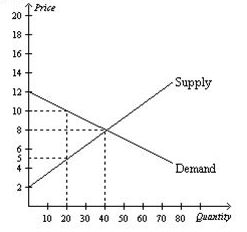Answer the following questions based on the graph that represents J.R.'s demand for ribs per week at Judy's Rib Shack.
a. At the equilibrium price, how many ribs would J.R. be willing to purchase?
b. How much is J.R. willing to pay for 20 ribs?
c. What is the magnitude of J.R.'s consumer surplus at the equilibrium price?
d. At the equilibrium price, how many ribs would Judy be willing to sell?
e. How high must the price of ribs be for Judy to supply 20 ribs to the market?
f. At the equilibrium price, what is the magnitude of total surplus in the market?
g. If the price of ribs rose to $10, what would happen to J.R.'s consumer surplus?
h. If the price of ribs fell to $5, what would happen to Judy's producer surplus?
i. Explain why the graph that is shown verifies the fact that the market equilibrium quantity) maximizes the sum of producer and consumer surplus.
Definitions:
Wrong Word
The use of a word in a context that does not fit its meaning, often leading to confusion or misunderstanding.
Agreement Issue
A problem or dispute arising from differing interpretations or violations of a formal agreement.
Noun
A part of speech that names a person, place, thing, or idea.
Subordinate Clauses
Clauses that cannot stand alone as complete sentences and function within a sentence to provide additional information.
Q25: The distinction between efficiency and equality can
Q78: Other things equal, the deadweight loss of
Q89: Refer to Figure 7-23. The equilibrium price
Q101: Economists generally agree that the most important
Q130: Refer to Figure 7-20. For quantities less
Q142: The marginal seller is the seller<br>A) for
Q215: Taxes affect market participants by increasing the
Q266: Suppose that Firms A and B each
Q325: Refer to Figure 7-32. How much are
Q367: Refer to Figure 8-9. The imposition of